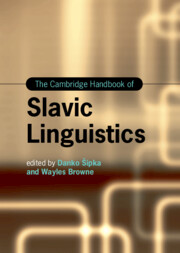Book contents
- The Cambridge Handbook of Slavic Linguistics
- Cambridge Handbooks in Language and Linguistics
- The Cambridge Handbook of Slavic Linguistics
- Copyright page
- Contents
- Figures
- Tables
- Contributors
- Introduction
- Part 1 Prosody and Phonology
- Part 2 Inflectional and Derivational Morphology
- Part 3 Syntax
- Part 4 Lexicon
- Part 5 Sociolinguistic and Geographical Approaches
- Part 6 Experimental and Quantitative Approaches
- 34 Psycholinguistics and Language Acquisition
- 35 Natural Language Processing
- Name Index
- Subject Index
- References
35 - Natural Language Processing
from Part 6 - Experimental and Quantitative Approaches
Published online by Cambridge University Press: 16 May 2024
- The Cambridge Handbook of Slavic Linguistics
- Cambridge Handbooks in Language and Linguistics
- The Cambridge Handbook of Slavic Linguistics
- Copyright page
- Contents
- Figures
- Tables
- Contributors
- Introduction
- Part 1 Prosody and Phonology
- Part 2 Inflectional and Derivational Morphology
- Part 3 Syntax
- Part 4 Lexicon
- Part 5 Sociolinguistic and Geographical Approaches
- Part 6 Experimental and Quantitative Approaches
- 34 Psycholinguistics and Language Acquisition
- 35 Natural Language Processing
- Name Index
- Subject Index
- References
Summary
This chapter surveys the history and main directions of natural language processing research in general, and for Slavic languages in particular. The field has grown enormously since its beginning. Especially since 2010, the amount of digital texts has been rapidly growing; furthermore, research has yielded an ever-greater number of highly usable applications. This is reflected in the increasing number and attendance of NLP conferences and workshops. Slavic countries are no exception; several have been organising international conferences for decades, and their proceedings are the best place to find publications on Slavic NLP research. The general trend of the evolution of NLP is difficult to predict. It is certain that deep learning, including various new types (e.g. contextual, multilingual) of word embeddings and similar ‘deep’ models will play an increasing role, while predictions also mention the increasing importance of the Universal Dependencies framework and treebanks and research into the theory, not only the practice, of deep learning, coupled with attempts at achieving better explainability of the resulting models.
Keywords
- Type
- Chapter
- Information
- The Cambridge Handbook of Slavic Linguistics , pp. 732 - 750Publisher: Cambridge University PressPrint publication year: 2024

